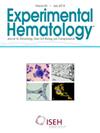Patterns of hemolysis, erythropoiesis, and iron distribution define unique disease trajectories in three mouse models of genetic anemia
IF 2.1
4区 医学
Q2 HEMATOLOGY
引用次数: 0
Abstract
Hemolytic anemias involve premature red blood cell (RBC) destruction and present complex phenotypes, including disturbances in iron metabolism, extramedullary erythropoiesis, and systemic organ involvement. To guide the selection of appropriate murine models for studying pathophysiology and pharmacologic treatments of human hemolytic disorders, we systematically characterized three genetic mouse models commonly used to investigate such conditions: sickle cell disease (SCD), β-thalassemia (THAL), and hereditary spherocytosis (SPH). We sought to clarify how these models differ in the severity and nature of hemolysis, the balance between erythropoietic responses and iron regulation, and the long-term patterns of iron distribution. Our findings reveal that SPH mice exhibit severe intravascular hemolysis and suppressed hepcidin levels, leading to unopposed intestinal iron absorption and extensive tissue iron loading, especially in the liver. In contrast, SCD and THAL mice display predominantly extravascular hemolysis, moderate anemia, relatively stable hepcidin levels, and balanced erythropoiesis with partially regulated iron overload. Single-cell ribonucleic acid (RNA) sequencing of spleens highlighted distinct erythropoietic progenitor distributions, whereas iron-isotope tracing experiments confirmed divergent RBC turnover kinetics and tissue distribution. This study defines distinct disease trajectories for common hemolytic disease models by providing a unique comparative framework. Our work will support more informed model selection and refined experimental design to investigate hemolytic anemia pathobiology and therapeutics.
在三种遗传性贫血小鼠模型中,溶血、红细胞生成和铁分布的模式定义了独特的疾病轨迹。
溶血性贫血涉及过早的红细胞(RBC)破坏,并呈现复杂的表型,包括铁代谢紊乱,髓外红细胞生成和全身器官受累。为了指导选择合适的小鼠模型来研究人类溶血疾病的病理生理和药理治疗,我们系统地描述了三种常用的遗传小鼠模型:镰状细胞病(SCD)、β -地中海贫血(THAL)和遗传性球形红细胞增生症(SPH)。我们试图澄清这些模型在溶血的严重程度和性质、红细胞生成反应和铁调节之间的平衡以及铁分布的长期模式方面的差异。我们的研究结果表明,SPH小鼠表现出严重的血管内溶血和抑制hepcidin水平,导致肠道铁吸收和广泛的组织铁负荷,特别是在肝脏。相比之下,SCD和THAL小鼠主要表现为血管外溶血,中度贫血,相对稳定的hepcidin水平,以及部分调节铁过载的红细胞生成平衡。脾脏的单细胞RNA测序突出了不同的红细胞祖细胞分布,而铁同位素示踪实验证实了不同的红细胞周转动力学和组织分布。本研究通过提供独特的比较框架,定义了常见溶血性疾病模型的不同疾病轨迹。我们的工作将支持更明智的模型选择和完善的实验设计,以研究溶血性贫血的病理生物学和治疗方法。摘要:我们比较了三种遗传性小鼠模型——镰状细胞病、-地中海贫血和遗传性球胞症——以揭示溶血性贫血的不同疾病机制。我们的研究结果表明,遗传性球形红细胞增多症诱导严重的血管内溶血和铁超载,而镰状细胞和β -地中海贫血模型表现出血管外溶血,铁分布更受调节。本研究为溶血性贫血研究的模型选择提供了重要的见解,并为研究溶血性贫血的病理生理和治疗提供了框架。
本文章由计算机程序翻译,如有差异,请以英文原文为准。
求助全文
约1分钟内获得全文
求助全文
来源期刊

Experimental hematology
医学-血液学
CiteScore
5.30
自引率
0.00%
发文量
84
审稿时长
58 days
期刊介绍:
Experimental Hematology publishes new findings, methodologies, reviews and perspectives in all areas of hematology and immune cell formation on a monthly basis that may include Special Issues on particular topics of current interest. The overall goal is to report new insights into how normal blood cells are produced, how their production is normally regulated, mechanisms that contribute to hematological diseases and new approaches to their treatment. Specific topics may include relevant developmental and aging processes, stem cell biology, analyses of intrinsic and extrinsic regulatory mechanisms, in vitro behavior of primary cells, clonal tracking, molecular and omics analyses, metabolism, epigenetics, bioengineering approaches, studies in model organisms, novel clinical observations, transplantation biology and new therapeutic avenues.
 求助内容:
求助内容: 应助结果提醒方式:
应助结果提醒方式:


